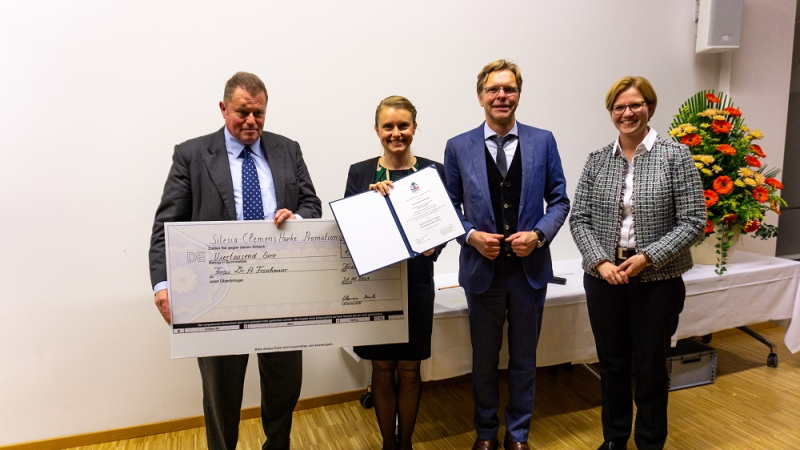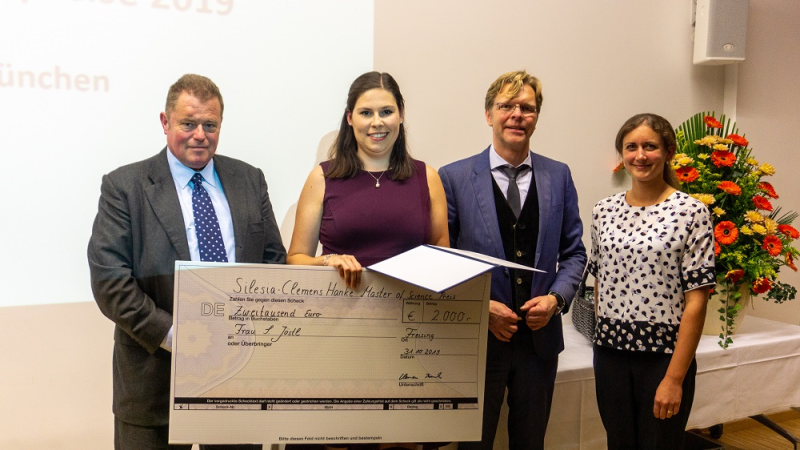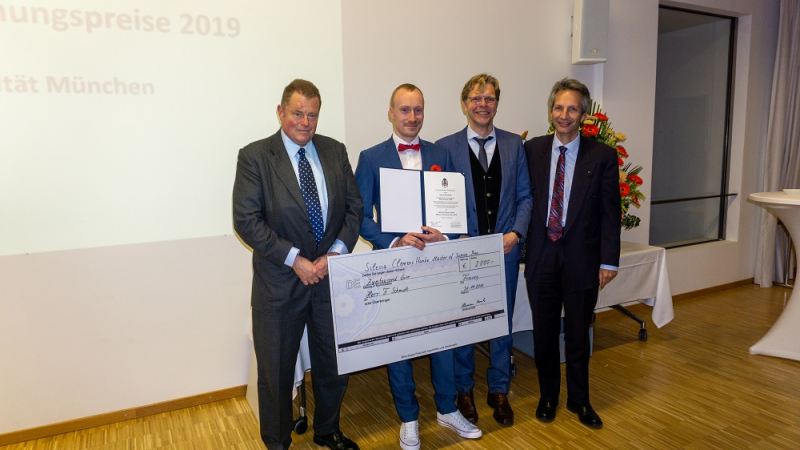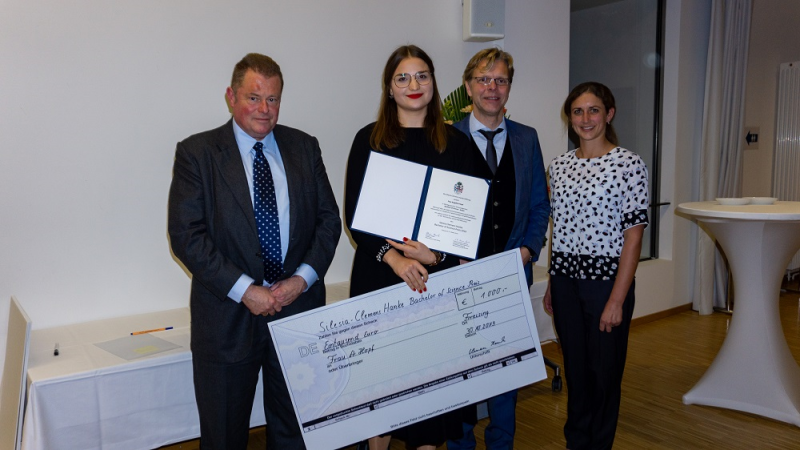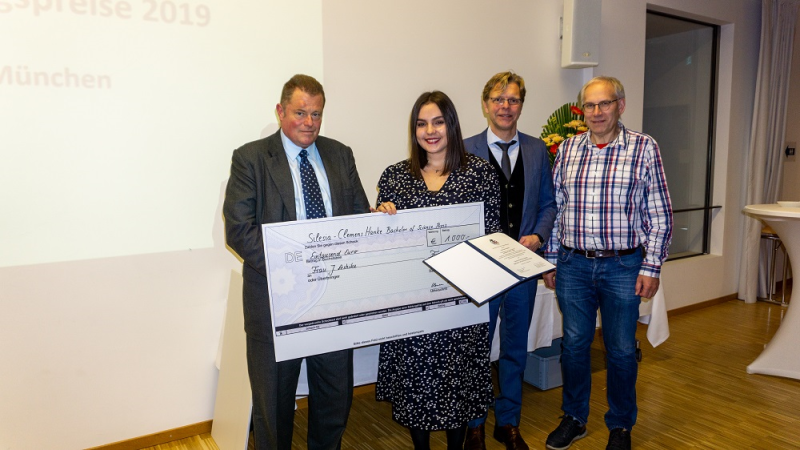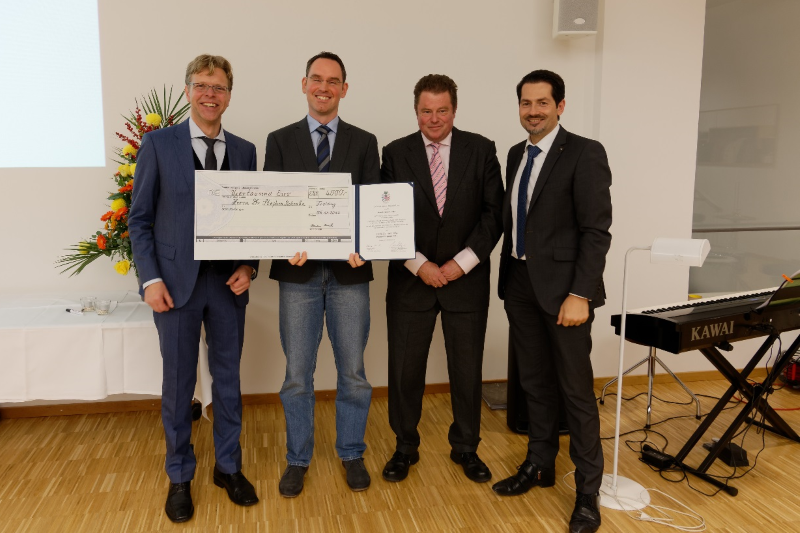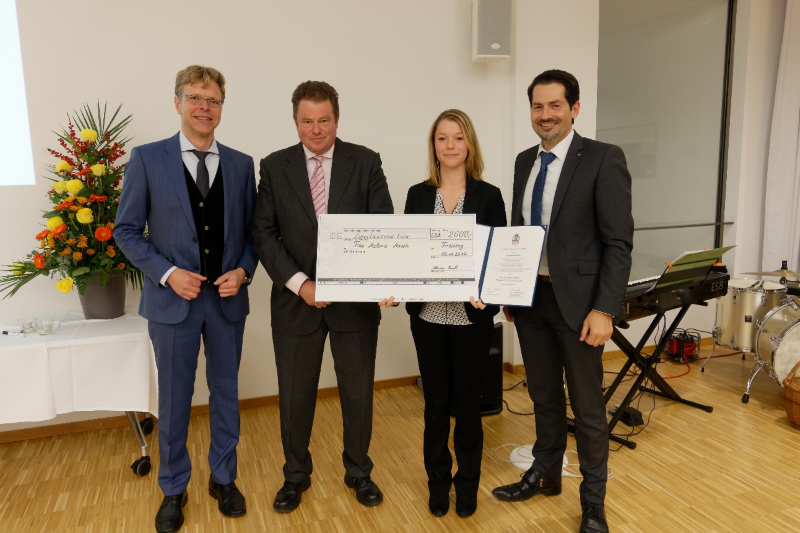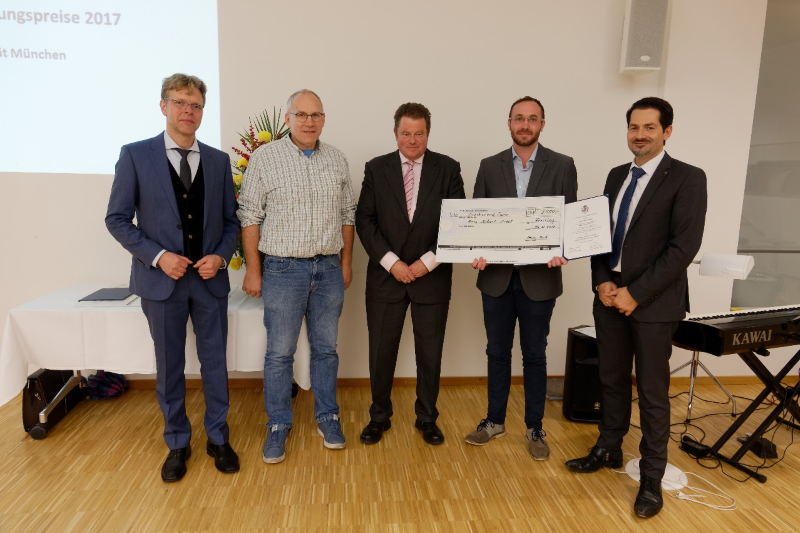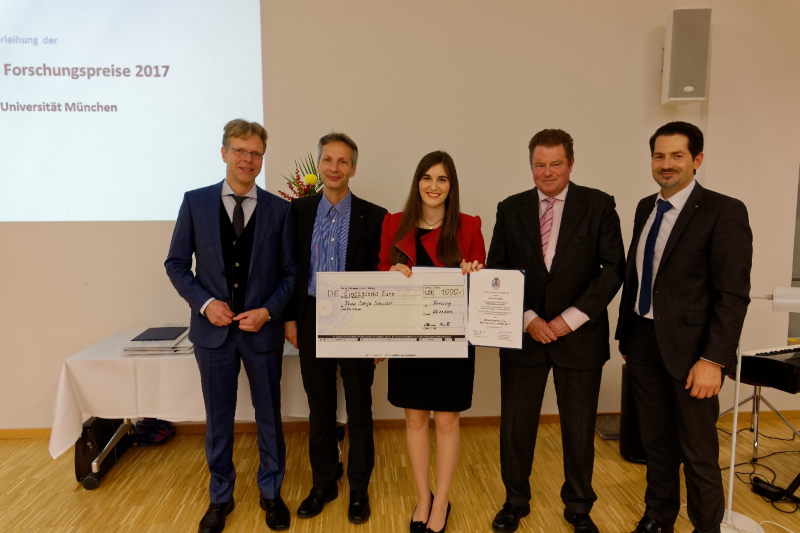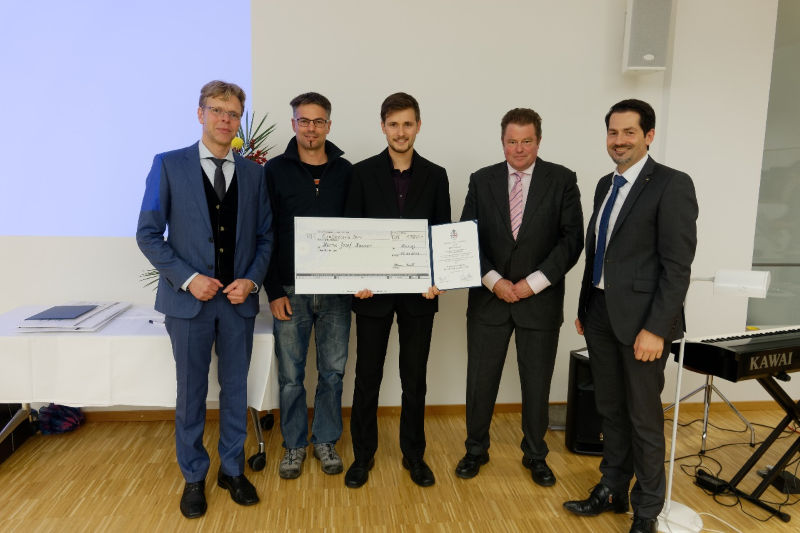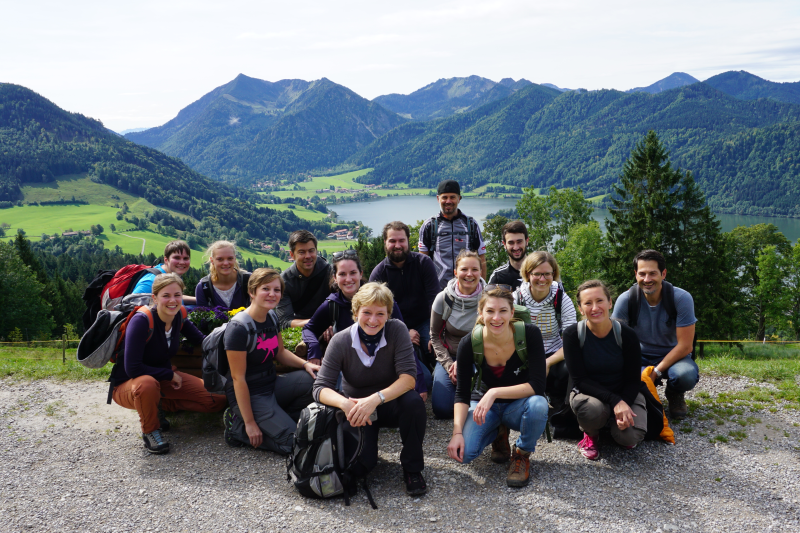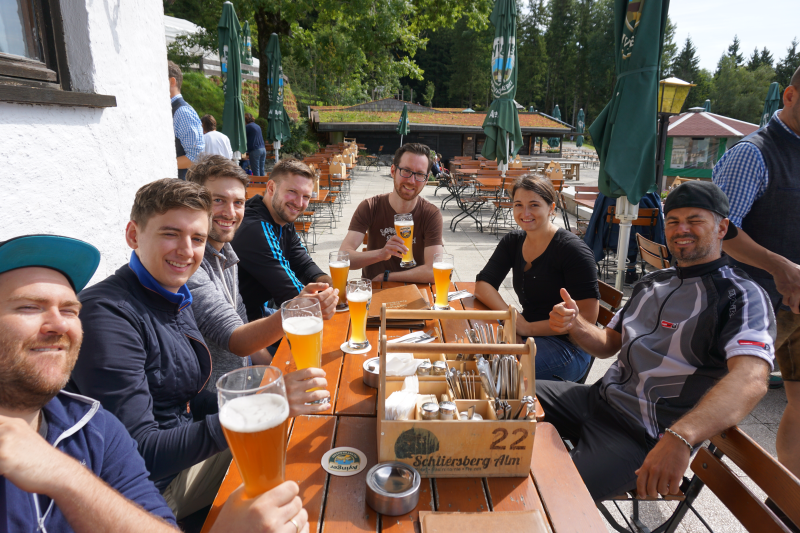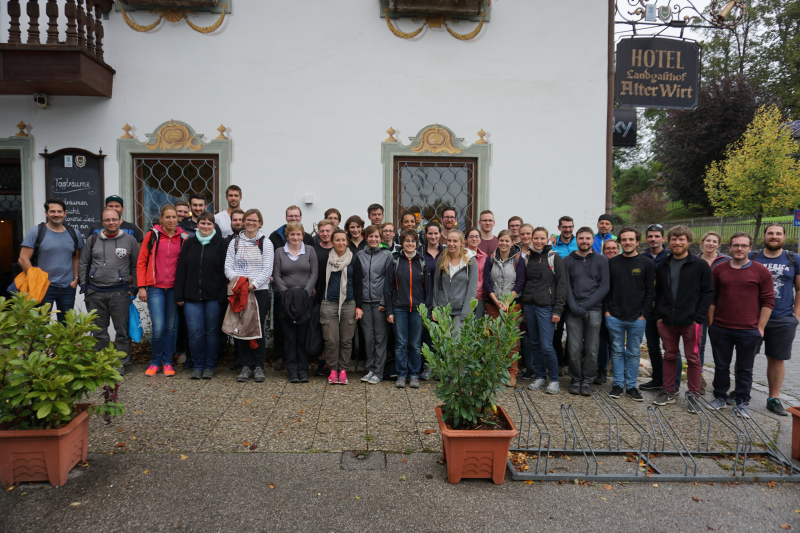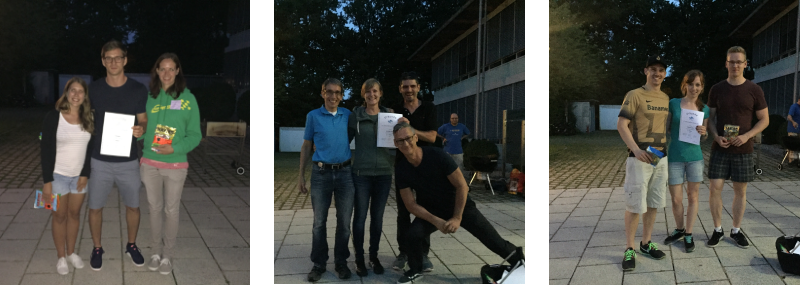News archive 2019 - 2017

Graduation of Verena Mittermeier
November 29, 2019
We congratulate our colleague Verena Mittermeier for the passed oral examination on her PhD thesis. She obtained the academic title "Dr. rer. nat." for her thesis on key taste compounds and taste modulating compounds in chanterelles.
Award Ceremony 2019 for the Silesia-Clemens Hanke Research Awards at the Technical University of Munich
November 15, 2019
The Silesia-Clemens Hanke-Stiftung awarded the annual research awards for young scientists at the TUM School of Life Sciences Weihenstephan of the Technical University of Munich (TUM) on October 31, 2019.
Clemens Hanke established the Silesia-Clemens Hanke-Stiftung in 2015 upon the realization, that the most sustainable investment in Germany’s future would be finding and supporting young talents in science. The foundation ensures the independent management of the global flavor producer Silesia, a family business found in 1910 that employs over 900 experts. Since 1996, the successful entrepreneur Clemens Hanke is CEO of the Silesia Group.
The foundation supports food chemistry graduates of the Bachelor of Science-, Master of Science- and doctoral program at TUM since 2017. One goal of the long-term cooperation for talented researchers is to honor young TUM scientists for excellent research results in food chemistry. The Silesia-Clemens Hanke-Stiftung and the Technical University of Munich congratulate this year’s laureates and wish them every success for their scientific future.
The Silesia-Clemens Hanke Dissertation Award 2019 is worth 4,000 Euro and honors Dr. Andrea Froschmeier for her excellent thesis “Molecular characterization of key taste compounds in Whisky” at the Chair of Food Chemistry and Molecular Sensory Science of the Technical University of Munich. Andrea Froschmeier identified marker molecules of various chemical classes for Single Malt Whiskeys and Bourbon Whiskeys with highly innovative methods. Advanced methods of mass spectrometry and human sensory science as well as receptor-based techniques characterized the complex chemical and sensorial interactions of the different whiskey compounds.
The Silesia-Clemens Hanke Master of Science Awards 2019 with 2,000 Euro, respectively, are presented to:
- Sarah Jöstl for her Master of Science thesis “α-Amylase-Trypsin-Inhibitors in processed and native food products with wheat, barley or rye“ at the Leibniz Institute for Food System Biology at the Technical University of Munich.
- Frank Schmidt for his Master of Science thesis “Isolation, identification and characterization of secondary metabolites of Alternaria cultures“ at the Chair of Analytical Food Chemistry.
The Silesia-Clemens Hanke Bachelor of Science Awards 2019 with 1,000 Euro, respectively, are presented to:
- Angelina Hopf for her Bachelor of Science thesis “Overview on the nutrient composition of gluten-free food in comparison to native food containing gluten” at the Leibniz Institute for Food System Biology at the Technical University of Munich.
- Joana Ashiku for her Bachelor of Science thesis “Production and purification of recombinant Mal d1 in Escherichia coli and allergen quantification in apples“ at the Associate Professorship of Biotechnology of Natural Products.
Welcome!
November 1, 2019
We'd like to give a warm welcome to Dr. Mark Somoza. Together with a team at the Leibniz-Institute for Food Systems Biology at the Technical University of Munich (LSB), he develops and applies large-scale photolithographic nucleic acid microarray synthesis for traditional and novel bioanalytical applications. He specializes on gene expression analysis for sRNA detection and analysis, spatial transcriptomics of tissue sections via RNA capture for food and nutritional physiology research, and nucleic acid based aptamer and antibody mimics for target binding and detection. We are looking forward to having him in our research group and wish him and his team a lot of success for all their experiments.
“Smoke detectors” in plants also control the growth of root hair
How roots grow hair
October 17, 2019
The roots of plants can do a lot of things: They grow in length to reach water, they can bend to circumvent stones, and they form fine root hairs enabling them to absorb more nutrients from the soil. A team of researchers led by scientists at the Technical University of Munich (TUM) has now identified an important regulator of this process.
If a forest fire destroys larger plants, seeds of so called fire-followers see their chance: these have a receptor protein that can “smell” certain molecules generated in smoke of burnt plant material. The receptor protein called KAI2 sets off a signal cascade causing the seeds to germinate.
A team of researchers led by Caroline Gutjahr, professor for plant genetics at the TUM School of Life Sciences Weihenstephan, has now discovered that it also plays an important role in regulating the growth of roots.
Root hairs increase the root surface area
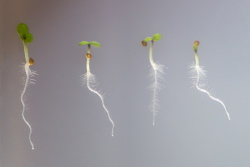
To achieve a large surface area through which water and nutrients can be absorbed, the roots of plants grow fine root hairs. José Antonio Villaécija-Aguilar, a Ph. D. student in Caroline Gutjahr’s team, has now made the discovery that KAI2 is both necessary for the growth of this root hair and for the downward growth of roots.
“It is likely that this not only applies to the thale cress (Arabidopsis), which can be found almost everywhere in the world and is used by us as a model plant,” Caroline Gutjahr says, “but possibly also for many other plants, for example cereal crops.”
Smoke molecules cause root hairs to grow
To check their hypothesis, the team of researchers exposed young arabidopsis plants to the molecules (called karrikins) present in smoke. This indeed significantly increased the growth of root hairs.
“Our results are also interesting in the light of evolution,” Caroline Gutjahr says. “It is likely that KAI2 was initially responsible for controlling certain development processes in all plants, such as, for example, the development of root hairs and similar structures, in reaction to a plant hormone that is so far unknown. In the course of evolution of fire-activated seeds, KAI2 thas presumably developed the additional feature of detecting smoke.”
Use in plant breeding
The findings not only promote a more thorough understanding of how plants work, but can also be important for future sustainable agriculture.
“With this new and better understanding, of which molecular mechanisms play a role in the development of roots and root hairs, we can breed plants which are better able to absorb nutrients and water from the soil,” Caroline Gutjahr says. “This can for example help crops to resist longer periods of drought, which may occur more frequently in the future.”
More information
The work underlying this publication was funded by the Deutsche Forschungsgemeinschaft (DFG; German Research Association) within the scope of the Emmy Noether program (Caroline Gutjahr) and SFB 924 (Corinna Dawid) and the British Biotechnology and Biological Sciences Research Council (BBSRC) (Tom Bennett). The research group of the Assistant Professorship of Plant Genetics (Caroline Gutjahr) cooperated with researchers of the Chair of Food Chemistry and Molecular Sensory Science of the TUM (Corinna Dawid) and the Centre for Plant Science (Tom Bennett) of the University of Leeds (UK).
Welcome to our team!
October 1, 2019
Our research teams warmly welcome Anna Gabler and Josef Ranner. Both graduated in master studies of food chemistry at the Technical University of Munich and are going to work on PhD theses in our institute. Anna Gabler researched high molecular compounds in coffee during her master thesis, Josef Ranner investigated unpolar fractions of cocoa. We are looking forward to working with both of them the next years and wish the best of success!
Food profilers develop new methodological approach for food analysis
Better food quality control
July 30, 2019
Scientists at the Technical University of Munich (TUM) and the Leibniz-Institute for Food Systems Biology have developed a new methodology for the simultaneous analysis of odorants and tastants. It could simplify and accelerate the quality control of food in the future.
Whether a food tastes good or not is essentially determined by the interaction of odors and tastants. A few trillionths of a gram per kilogram of food is enough to perceive some odorants. Tastants, on the other hand, we only recognize at significantly higher concentrations.
In order to guarantee consistent sensory quality, it is very important for manufacturers to know and control the characteristic odor and taste profiles of their products from the raw material to the finished product. This requires a fast but precise food analysis.
Tastants and aroma substances, however, differ greatly in their chemical and physical properties. As a result, food chemists currently use very different methods to determine the exact nature and quantity of odorants and tastants in a raw material or food. Especially aroma analyses are very time-consuming and therefore expensive. This limits the high-throughput analysis of numerous samples.
One methodical approach for two different substance classes
Thomas Hofmann, Director of the Leibniz-Institute for Food Systems Biology and Professor of Food Chemistry and Molecular Sensory Science at the TUM, explains: "We have now developed a new, innovative methodical approach that will enable us to examine food simultaneously for both odorants and tastants in a time-saving high-throughput process. It is based on an ultra-high performance liquid chromatography mass spectrometry (UHPLC-MS) method typically used for taste analysis.
The new and time-saving feature of the developed approach is that volatile odorous substances can now also be analyzed by means of an upstream enrichment or substance conversion step using this method, which is otherwise not used for aromatic substances.
Apple juice as a test object
"We have tested our new methodological approach using apple juice as an example. The results are very promising," says Andreas Dunkel, Senior Scientist at the Leibniz-Institute of Food Systems Biology. Together with doctoral student Christoph Hofstetter from the TUM, he was substantially involved in the development of the new approach.
According to the scientists, the new method makes it possible for the first time to analyze a large number of samples in a very short time with regard to their taste and odor giving ingredients.
Also suitable for food profiling
The researchers hope to be able to further develop the method so that it can be used by food manufacturers in the future to quickly and easily monitor the flavor of food along the entire value chain and, if necessary, optimize it.
Last but not least, the new method could also be used to stop food fraud. "Using the identified flavor profiles, it would be possible to check the origin and quality label of the manufacturers and detect food fraud," says food profiler and food chemist Andreas Dunkel.
More information
The scientific project was carried out within the framework of the „enable“ competence cluster of nutrition research funded by the Federal Ministry of Education and Research of Germany (BMBF). Its aim is to develop new strategies that promote healthy eating behavior in society. This contributes significantly to the prevention of common diseases such as type 2 diabetes, cardiovascular diseases, certain types of cancer and obesity. This also includes well-controlled, tasty foods that support healthy eating habits.
Graduation of Benedikt Kohles
July 9, 2019
We congratulate Benedikt Kohles for the passed oral examination on his PhD thesis. He obtained the academic title "Dr. rer. nat." for his thesis on stable-isotope labeling studies on structures and formation pathways within the Maillard reaction of lysine in protein side chains.
Graduation of Dr. Maximilian Dietz
May 29, 2019
We congratulate Maximilian Dietz for the passed oral examination on his PhD thesis. He obtained the academic title "Dr. rer. nat." for his thesis on the molecular identification and characterization of foam-active compounds in beer and on studies on the influence of beer foam on aroma release.
Graduation of Dr. Johanna Lainer and Dr. Kirsten Günther-Jordanland
May 28, 2019
We congratulate Johanna Lainer and Kirsten Günther-Jordanland for their newly obtained academic title "Dr. rer. nat.". Johanna Lainer finished her thesis on the molecular and sensory characterization of the bitter off-taste in poppy seeds, Kirsten Günther-Jordanland characterized the valuable bitter tastants of oat on a molecular level.
Welcome!
May 1, 2019
We gladly welcome Sebastian Wurzer to our team. Mr. Wurzer supports the scientific work of our research teams with his expertise as chemical-technical assistant. We are wishing him the best of luck for his experiments and are looking forward to having him in our team.
Graduation of Dr. Barbara Singldinger and Dr. Matthias Bader
April 23, 2019
We congratulate Dr. Barbara Singldinger and Dr. Matthias Bader for their newly obtained academic title "Dr. rer. nat.". Barbara Singldinger finished her thesis on molecular-sensory studies on the bitter off-taste of hazelnuts. Matthias Bader published his results on the influence of chemosensory active compounds on metabolome, proteome and functionality of human saliva.
Plant immune system detects bacteria through small fatty acid molecules
How plants defend themselves
April 11, 2019
Like humans and animals, plants defend themselves against pathogens with the help of their immune system. But how do they activate their cellular defenses? Researchers at the Technical University of Munich (TUM) have now discovered that receptors in plant cells identify bacteria through simple molecular building blocks.
"The immune system of plants is more sophisticated than we thought," says Dr. Stefanie Ranf from the Chair of Phytopathology of the TU Munich. Together with an international research team, the biochemist has discovered substances that activate plant defense.
Until now, scientists have thought that plant cells – similar to those of humans and animals – recognize bacteria through complex molecular compounds, for example from the bacterial cell wall. In particular, certain molecules composed of a fat-like part and sugar molecules, lipopolysaccharides or LPS for short, were suspected of triggering an immune response.
In 2015, Ranf's team successfully identified the respective receptor protein: lipo-oligosaccharide-specific reduced elicitation, or LORE for short. All experiments indicated that this LORE protein activates the plant cell's immune system when it detects LPS molecules from the cell wall of certain bacteria.
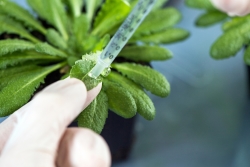 |
A throwback leads to the right track
"The surprise came when we wanted to study this receptor protein more closely," recalls Ranf. "Our goal was to find out how LORE distinguishes different LPS molecules. For this we needed high-purity LPS. "
The researchers found that only LPS samples with certain short fatty acid constituents triggered plant defense. Surprisingly, they found in all these active LPS samples also extremely strong adhering free fatty acid molecules. Only after months of experimentation was the team able to separate these free fatty acids from the LPS.
"When we finally succeeded in producing highly purified LPS, it became apparent that the plant cell did not respond to them at all! Thus, it was clear that the immune response is not triggered by LPS, but instead by these short fatty acids" said Ranf.
Focussing on bacteria building blocks
The 3-hydroxy fatty acids are very simple chemical building blocks compared to the much larger LPS. They are indispensable for bacteria and are produced in large quantities for incorporation into diverse cellular components. "The strategy of plant cells to identify bacteria through these basic building blocks is extremely sophisticated; the bacteria require these 3-hydroxy fatty acids and therefore cannot bypass the immune response," summarizes Ranf.
In the future, these results could help in breeding or genetically engineering plants with an improved immune response. It is also conceivable that plants treated with 3-hydroxy fatty acids would have increased resistance to pathogens.
More information
The work was performed by an international and interdisciplinary collaboration of plant molecular biologists, chemists, and microbiologists. In addition to the Chair of Phytopathology and the Chair of Food Chemistry and Molecular Sensory Science of TUM, the Research Center Borstel (Leibniz Lung Center), the Helmholtz Zentrum München, the Austrian Gregor Mendel Institute for Molecular Plant Biology, the University of Maryland / USA, and the French University of Reims Champagne-Ardenne were involved in this work.
Stefanie Ranf’s research was funded by the German Research Foundation (DFG) as part of the Collaborative Research Center (SFB) 924 and the Emmy Noether Program.
Welcome!
April 8, 2019
We are pleased to welcome Benedikt Stiglbauer to our scientific team. Mr. Stiglbauer majored in Food Chemistry at the Technical University of Munich and is going to cooperate with NPTC Food in Singen for the experiments on his PhD thesis. We are excited to see the results of his experiments and are looking forward to working with him.
Welcome to our team!
March 7, 2019
We'd like to warmly welcome Daniela Hartl and Andrea Spaccasassi to our research teams. Ms. Hartl graduated in Food Chemistry at the Technical University of Munich and is going to work on her PhD thesis as a valuable part of our team. Mr. Spaccasassi graduated as Master of Science in Food Technology in the Netherlands and will also join us for his PhD thesis. We are looking forward to working with both of them and wish all the best of success for their experiments!
How rapeseed could be used as a protein source for human nutrition
Bitter rapeseed
January 1, 2019
Rapeseed doesn't just contain oil but high-quality protein, too. However, protein extracts from rapeseed have an intense, bitter off-taste. A team led by food chemist Thomas Hofmann has now identified the substance that is pivotal for the bitter taste. This is a first step towards developing rapeseed for the human protein supply.
According to the Food and Agriculture Organization of the United Nations (FAO), the demand for food will approximately double by 2050 due to the growing world population. "Bottlenecks are to be expected in this context, particularly in protein supply," says Thomas Hofmann, who heads the Chair of Food Chemistry and Molecular Sensory Science at the Technical University of Munich (TUM).
According to Hofmann, who is also Director of the Leibniz-Institute for Food Systems Biology, it is therefore important to develop new plant protein sources for human nutrition. And rapeseed is a good local source.
Rapeseed contains high-quality protein
Rapeseed doesn't just contain oil but high-quality protein too, which contains many essential amino acids. Worldwide around 1.12 million tons of crude protein are produced annually from rapeseed oil. Although farmers have long used this so-called rapeseed cake as a protein feed for animals, it has not played a role as a protein source in human nutrition so far.
One reason is that the accompanying substances contained in rapeseed strongly impair the taste of the obtained protein isolates. These substances include, for example, very bitter-tasting secondary plant constituents. Hofmann and his team therefore looked into the issue of which bitter substances cause the rapeseed protein's unpleasant bad taste.
The key substance that makes rapeseed protein taste bitter
The researchers investigated three different protein isolates using mass spectrometric analysis methods and taste tests. The first isolate was an extract of all the proteins contained in rapeseed meal. The second isolate predominantly contained cruciferin and the third napin, which are the rapeseed's two main storage proteins. All three isolates had a protein content of 80 to 90 percent.
As the investigations show for the first time, a compound called kaempferol 3-O-(2‘‘‘-O-sinapoyl-ß-sophoroside) is the key substance that makes protein extracts from rapeseed inedible. The cruciferin isolate in particular contained a large amount of this bitter substance with 390 milligrams per kilogramme. The rapeseed meal and napin isolate had less than a tenth of the quantity, but still tasted bitter in the sensory test.
Starting point for new processes
"Since we now know the cause of the bitter off-taste, it is much easier to develop suitable technological processes or breeding strategies that can be used to produce tasty, protein-rich foods from rapeseed," said co-author Corinna Dawid, who heads the Phytometabolomics research group at TUM.
Welcome to our team!
January 15, 2019
We welcome Susanne Wudy to our scientific team! Ms. Wudy finished her studies in food chemistry with a MSc degree of the Technical University of Munich and researched on cyclo-linopeptides for her master thesis at the Bavarian Center for Biomolecular Mass Spectrometry (BayBioMS). We are wishing all the best of success for her experiments and an exciting time at our institution.

Graduation of Dr. Andrea Froschmeier
December 7, 2018
We congratulate Dr. Andrea Froschmeier on the passed oral examination to her PhD thesis. She finished her work on the molecular characterization of key taste compounds in whisky and obtained the academic title "Dr. rer. nat." for it.
Welcome!
November 13, 2017
We'd like to give a warm welcome to Dr. Dong Liang, who joins our research team for receptor studies. Mr. Liang is going to work with us and the cell biology experts of the Leibniz Institute of food systems biology at the Technical University of Munich (LSB). We are looking forward to having him in our scientific team and wish him a lot of success for all his experiments.
Welcome!
December 1, 2018
We gladly welcome Anja Beusch back to our team. Ms. Beusch worked with us until 2016 and supported much of the research in the field of nutritional metabolomics. We are looking forward to having Anja Beusch in our team again and wishing her the best luck with her experiments.
The hunt for flavor-giving fragments
Making cheese & co. taste better
November 6, 2018
Researchers at the Technical University of Munich (TUM), the Leibniz-Institute for Food Systems Biology, and the University of Hohenheim have developed a new methodical approach. It allows for the faster identification of flavor-giving protein fragments in foods such as cheese or yogurt, thus optimizing production processes.
The taste of fermented foods such as cheese, yogurt, beer, yeast dough, or soy sauce is very popular with consumers worldwide. In addition to volatile aroma compounds, non-volatile substances also significantly contribute to their characteristic taste profile. Above all, these include fragments of long protein molecules that are produced, for example, during microbial or enzymatic conversion (fermentation) of milk or grain protein.
At present, however, it is still unclear which of the more than one thousand different protein fragments in fermented milk products are responsible for the flavor. One reason being that previously used analytical methods are very labor-intensive and time-consuming.
New analytical approach provides a solution
A team of scientists led by Professor Thomas Hofmann, Head of the Chair of Food Chemistry and Molecular Sensory Science at TUM, has developed a new analytical approach to address this problem. What makes the approach so innovative is that researchers combined existing methods of proteome research with methods of sensory research to efficiently and quickly identify the decisive flavor-giving protein fragments from the totality of all fragments. “We coined the term ‘sensoproteomics’ for this type of procedure,” said Andreas Dunkel from the Leibniz-Institute for Food Systems Biology, the lead researcher for the study.
The team of scientists tested the effectiveness of the newly developed procedure for the first time on two different varieties of cream cheese with different degrees of bitterness. The objective was to identify the specific protein fragments responsible for a bitter off-flavor in cheese that occurs under certain production conditions.
The team of scientists tested the effectiveness of the newly developed procedure for the first time on two different varieties of cream cheese with different degrees of bitterness. The objective was to identify the specific protein fragments responsible for a bitter off-flavor in cheese that occurs under certain production conditions.
An approach to reduce 1,600 possibilities to 17
The researchers started their work with an extensive review of the literature. They concluded that a total of approx. 1,600 different protein fragments contained in dairy products could theoretically be responsible for the bitterness. Subsequent liquid chromatography-coupled mass spectrometer investigations assisted by in-silico methods reduced the number of potential protein fragments to 340. Finally, comparative spectrometric, sensory and quantitative analyses reduced the number of fragments responsible for the bitter cheese flavor to 17.
Prof. Hofmann, who is also the Director of the Leibniz-Institute for Food Systems Biology at TUM, is convinced that “The sensoproteomics approach we have developed will in the future contribute to the rapid and efficient identification of flavor-giving protein fragments in a wide range of foods using high-throughput methods — a significant help in optimizing the taste of products.”
Welcome to our team!
November 1, 2018
We gladly welcome Sabrina Schalk to our team! Ms. Schalk studied food chemistry at the Technical University of Munich and graduated with a MSc degree. She is going to research the microbiome of lotus plants within a DFG-funded project with Dr. Dawid. We are looking forward to exciting results and are wishing all the best of success for her time at our institution.
FEMA Excellence in Flavor Science Award 2018

October 22, 2018
Prof. Dr. Thomas Hofmann has been awarded the FEMA Excellence in Flavor Science Award 2018 at the FEMA 49th Fall Symposium in New York, USA.
The Flavor and Extract Manufacturers Association of the United States (FEMA) is comprised of flavor manufacturers, flavor users, flavor ingredient suppliers, and others with an interest in the U.S. flavor industry. One of their most noted developments was the FEMA GRAS list, promoting the generally recognized as safe concept for flavoring substance evaluations.
"The FEMA Excellence in Flavor Science Award was created by the FEMA Board of Governors to recognize individuals who have shown outstanding dedication to the advancement of flavor science", according to FEMA. The globally renowned award may be bestowed to highly-recognized researchers and esteemed experts of their field. Prof. Hofmann is the most recent award recipient, following other acclaimed experts like Wolfgang Meyerhof (2014) and Professor Peter Schieberle (2008).
Media coverage to the presidential election at the TUM
New TUM president: Thomas Hofmann is elected president of the Technical University of Munich
B5aktuell (BR), podcast, October 22, 2018
In the broadcast show "Das Campusmagazin" by B5aktuell (Bayerischer Rundfunk), Prof. Thomas Hofmann was interviewed on the occasion of the presidential election of the Technical University of Munich. The show aired on Sunday, October 21, 2018, and is available at the media library of the Bayerischer Rundfunk in German only.
Link to the broadcast at the BR media library (German)
Link to the complete episode (German)
Thomas Hofmann elected president of the Technical University of Munich
Süddeutsche Zeitung, online, 19.10.2018
An article about the election of Prof. Thomas Hofmann is published at the online platform of the newspaper Sueddeutsche Zeitung. The article in the category "Hochschule" is based on a phone interview and available in German only.
Thomas Hofmann elected as TUM’s new President
October 17, 2018
The Board of Trustees of the Technical University of Munich (TUM) has elected Prof. Thomas Hofmann (50) as the new President of TUM. The experienced university manager has held the position of Senior Vice President Research and Innovation at TUM since 2009. He made a significant contribution to TUM’s success in the Excellence Initiative, especially in developing the internationally acclaimed “TUM Faculty Tenure Track” recruitment and career system. Under his guidance, TUM also became Germany’s top university for the establishment of start-ups. The holder of the Chair of Food Chemistry and Molecular Sensory Science has received multiple awards for his research and teaching. On October 1, 2019, Hofmann will take over from Prof. Wolfgang A. Herrmann, whose far-reaching reforms in his 23-year tenure saw TUM rise to international top level.
Today’s vote by the Board of Trustees elected Prof. Thomas Hofmann to the six-year presidential term starting October 1, 2019. TUM’s Board of Trustees is made up of ten elected members of the Senate and ten external members from the worlds of science, business and politics.
“The Board of Trustees has succeeded in winning an internationally acclaimed scientist and experienced university manager as the next president of TUM. I am delighted about the nomination of Professor Thomas Hofmann and look forward to working with him,” says Prof. Otmar Wiestler, Chairman of the Board of Trustees and President of the Helmholtz Association.
Success in the excellence initiative
When he assumes his new office, Thomas Hofmann will have spent ten years in the role of Senior Vice President in charge of research and innovation. TUM has achieved several outstanding successes in this time, notably in the 2012 German Excellence Initiative. The centerpiece of its institutional strategy as a University of Excellence was the new „TUM Faculty Tenure Track“ recruitment and career system. Hofmann played a major role in the design and implementation of this system, which became the gold standard in German academia as it gives young scientists genuine career progression opportunities as well as early academic freedom. Since then, TUM has made around 100 Tenure Track appointments, drawing talent from the best research institutes in the world. Another 40 professorships were awarded to TUM under the 2017 federal and state tenure track program.
TUM ranks as one of Europe’s leading research universities, thanks not least to its successful management to support applications for funding. During Hofmann’s term as Vice President, TUM received almost 100 ERC Grants, which are among the highest-endowed research grants available in Europe. TUM and its partners were awarded funding for several Clusters of Excellence both in 2012 and in the recent round of funding last month. In 2016, in his role as Chairman of a European consortium, Hofmann himself led the winning team for the „EIT FOOD“ Knowledge and Innovation Community (KIC) competition held by the European Institute of Technology, which unites around 50 partners from science and industry.
Game-changing industry partnerships and start-up support
Hoffmann’s success in securing long-term framework agreements with industry players, including alliances with top global innovators like the recent Google win, has been a game-changer. Hofmann was also a driving force behind the “Industry on Campus” strategy, which invites companies like Siemens and SAP onto the Garching campus for research collaborations.
Under Hofmann’s leadership, TUM became a leading university in entrepreneurship. Around 70 new tech spin-offs are now established here every year, making TUM Germany’s number one university for start-up founders according to the relevant rankings.
Research and teaching in food chemistry
The future President obtained the Chair of Food Chemistry at the University of Münster in 2002. In 2007, he was appointed to TUM’s new Chair of Food Chemistry and Molecular Sensory Science. He turned down an offer from ETH Zurich at the time. Since 2015, Hofmann has held the position of Co-Director of the Bavarian Center for Biomolecular Mass Spectrometry (BayBioMS) at TUM, and he has been the Director of the TUM-affiliated Leibniz Institute for Food Systems Biology since 2017.
The 50-year-old’s research and teaching focus on the substances in plants and processed foods that are relevant for the human senses of taste and smell and for human metabolism. The scope of his work ranges from biomolecular basic research to the development of analysis methods for industry. Hofmann’s research has received international acclaim and he has played a major role in shaping the food chemistry study programs at TUM.
Succeeding the longest-serving university president in Germany
Thomas Hofmann will replace Wolfgang A. Herrmann (70), the longest-serving university president in Germany, on the TUM Board of Management on October 1, 2019. Since he took office in 1995, Herrmann has transformed TUM into the “Entrepreneurial University” and a driver of reform in the management of science and research in Germany. “Thomas Hofmann is an invaluable asset for TUM and the German higher education system,” declared Herrmann. “He will steer our university smoothly towards its future with his own particular entrepreneurial priorities. The institutional strategy underpinning the upcoming Excellence Initiative has already been strongly shaped by the new President. TUM is ready to hand the baton to the next generation in its usual efficient manner.”
Welcome to our team!
October 15, 2018
We are very pleased to welcome Johanna Barz and Florian Utz! Both finished their studies of food chemistry with a MSc degree at the Technical University of Munich and are going to join our international team of young scientists. We are looking forward to exciting results and are wishing both of them an interesting time at our institution.
Graduation of Dr. Christian Schmid
October 2, 2018
We congratulate Dr. Christian Schmid for his newly obtained academic title "Dr. rer. nat.". He finished his thesis on taste-active saponins in liquorice, including its structure determinations, psychophysical studies on them and their activity potential on human sweet and bitter taste receptors. He passed his oral examination on 2nd October, 2018 and received the denomination "summa cum laude" for his excellent achievements in the overall doctoral program.
Welcome to our team!
October 1, 2018
We are pleased to welcome Laura Amann to our scientific team! Ms. Amann finished her studies in food chemistry with a MSc degree of the Technical University of Munich and is going to research food biopolymers. We are wishing all the best of success for her experiments and an exciting time at our institution.
Fast 400.000 Euro für effiziente Wasseraufbereitung
02.08.2018
Ein bayerisches Forschungs- und Entwicklungskonsortium unter Führung der Technischen Universität München (TUM) erhält 398.900 Euro von der Bayerischen Forschungsstiftung für ein Projekt zur effizienten Steuerung von Wasseraufbereitungsanlagen: In enger Zusammenarbeit mit anderen Forschungseinrichtungen sowie Unternehmen möchte das Team um Projektleiter Dr. Karl Glas von der AG Wassertechnologie am TUM-Lehrstuhl für Lebensmittelchemie und molekulare Sensorik spezielle Fasersensoren entwickeln, die in der Aufbereitung von Trink- und Brauchwasser viel Energie und Zeit sparen können.
In vielen Weltregionen muss Trinkwasser aufwändig entsalzt werden, hierzulande ist diese Art der Wasseraufbereitung vor allem für industrielle Zwecke wichtig. Dafür werden Membranwickelmodule verwendet. Das Problem dabei: Häufig entstehen in den kompakten Modulen Ablagerungen (Fouling). Die Foulingentstehung ist derart komplex, dass heutige Vorhersagen zur Prozessauslegung fehlerträchtig sind und somit oftmals frühzeitiges Prozessversagen oder eine kontinuierliche aber ineffiziente Betriebsweise mit sich bringen.
Zur bestmöglichen Vermeidung von Prozessversagen werden Chemikalien zur Stabilisierung eingesetzt und regelmäßige Spülungen durchgeführt. Aufgrund mangelhafter Sensortechnik sind diese Maßnahmen derzeit kaum am tatsächlichen Bedarf orientiert, sondern beruhen zu großen Teilen auf Erfahrungs- und Schätzwerten. Durch den Fasersensor wird es möglich diese Maßnahmen in Zukunft am tatsächlichen Bedarf zu orientieren.
Beim Betrieb von Anlagen ohne erkennbare Foulingproblematik wird i.d.R. nicht das gesamte Aufbereitungspotential ausgeschöpft, weil mineralische Ausfällungen zuverlässig verhindert werden sollen und somit hohe Aufkonzentrierungen ausgeschlossen werden. Die Anlagenfahrweise ist dadurch nicht am Ausbeuteoptimum, sondern an der Sicherung eines kontinuierlichen Betriebs orientiert. Mit dem POF-Sensor werden zukünftig beide Ziele vereinbar, da durch die frühzeitige Ablagerungsdetektion mit dem neuen Sensor ein Art „Abtasten“ der höchstmöglichen Aufkonzentrierung möglich wird ohne Prozessversagen zu riskieren.
Das Projekt „POF-Foulingsensor für Membranen zur Wasseraufbereitung“ unter Führung der TUM will folgende Ziele erreichen:
- Ausfallzeiten der Anlagen und Modulverschleiß stark reduzieren
- Einsatz von Energie und Chemikalien beim Betrieb und Reinigung der Anlagen vermindern – bis zur kompletten Vermeidung
- Steigerung des Automatisierungsgrades und adaptive Prozessführung
- Grundlegendes Verständnis zu Ablagerungsvorgängen schaffen
Ziel des Vorhabens mit der Kurzbezeichnung „POF_Mem“ ist es deshalb, einen Fouling-Sensor auf Basis polymeroptischer Fasern (POF) so weiterzuentwickeln, sodass er künftig das Innenleben von Membranwickelmodulen zur Wasseraufbereitung überwachen kann. Die durch eine bedarfsgerechte Steuerung von Wasseraufbereitungsanlagen ermöglichte Effizienzsteigerung und Ressourcenschonung soll im Rahmen des Projekts ebenfalls demonstriert werden. In dem Projekt arbeitet die TUM mit der Technischen Hochschule Nürnberg, der Bayerischen Staatsbrauerei Weihenstephan, der Grünbeck Wasseraufbereitung GmbH aus Höchstädt a. d. Donau und dem Ingenieurbüro Heinl GmbH aus Zolling zusammen.
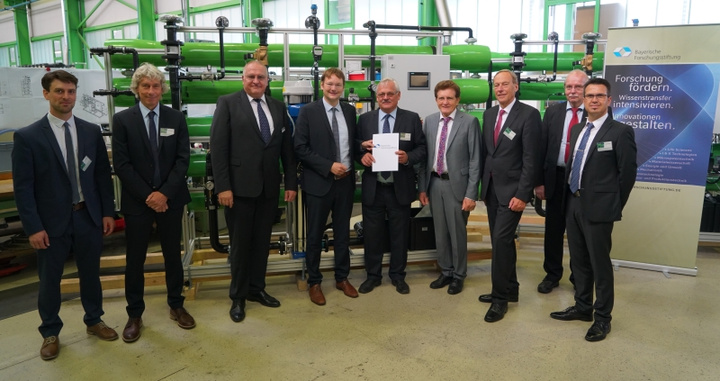 |
How food ingredients affect our taste perception - Pungent tasting substance in ginger reduces bad breath
July 27, 2018
The pungent compound 6-gingerol, a constituent of ginger, stimulates an enzyme contained in saliva – an enzyme which breaks down foul-smelling substances. It thus ensures fresh breath and a better aftertaste. Citric acid, on the other hand, increases the sodium ion content of saliva, making salty foods taste less salty. To find out more about food components, a team from the Technical University of Munich (TUM) and the Leibniz- Institute for Food Systems Biology investigated the effects of food components on the molecules dissolved in saliva.
Many food components contribute directly to the characteristic taste of food and beverages by means of contributing their own particular taste, scent or spiciness. However, they also indirectly influence our sense of taste via other, still largely unknown biochemical mechanisms. A team led by Professor Thomas Hofmann from the Chair of Food Chemistry and Molecular Sensory Science has now investigated this phenomenon in greater detail.
6-Gingerol ensures fresh breath
As the results of this study show, the pungent principle of ginger, the so-called 6-gingerol, makes the level of the enzyme sulfhydryl oxidase 1 in saliva increase 16-fold within a few seconds. The saliva and breath analyses carried out on human volunteers show that the enzyme breaks down malodorous sulfur-containing compounds. In this way, it is able to reduce the long-lasting aftertaste of many foods such as coffee. "As a result, our breath also smells better," explains Prof. Hofmann, who headed the study. The mechanism discovered could contribute to the future development of new oral hygiene products, says the head of the Leibniz- Institute for Food Systems Biology at the TUM.
Citric acid reduces our perception of saltiness
According to the study, citric acid influences our perception of taste through a completely different mechanism. As everyone knows from personal experience, sour foods such as lemon juice stimulate salivation. The amount of minerals dissolved in saliva also increases in proportion to the amount of saliva.
According to Prof. Hofmann, the sodium ion level in saliva rises rapidly by approximately a factor of eleven after stimulation with citric acid. This effect makes us less sensitive to table salt. The food chemist explains: "Table salt is nothing other than sodium chloride, and sodium ions play a key role in the taste of salt. If saliva already contains higher concentrations of sodium ions, samples tasted must have a significantly higher salt content in order to taste comparatively salty."
Hofmann believes that a great deal of research still needs to be done in order to understand the complex interaction between the molecules in food that create taste, the biochemical processes that take place in saliva and our sense of taste. Using a systems biology approach, Hofmann aims to develop a new scientific basis for the production of food with component and functional profiles that satisfy the health and sensory needs of consumers. To this end, he and his team are combining biomolecular research methods with high-performance analytical technologies and bioinformatics methods.
Graduation of Dr. Theresa Stolle
July 16, 2018
We congratulate Dr. Theresa Stolle on her freshly obtained academic title "Dr. rer. nat.". She finished her studies on peri-receptor events affecting salt taste sensitivity recently and passed the concluding oral examination. She received the well-deserved denomination "summa cum laude" for her outstanding academic work and her excellent performance in the oral examination.
Graduation of Dr. Junichiro Wakamatsu
July 10, 2018
We congratulate Junichiro Wakamatsu for the passed oral examination on his PhD thesis. He presented the results of his thesis on the activity-guided discovery of antioxidants in processed garlic extracts today and obtained the academic title "Dr. rer. nat." for his works.
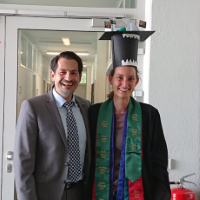
Graduation of Dr. Julia Stein
July 5, 2018
We congratulate Julia Stein for the passed oral examination on her PhD thesis today. She finished her thesis on the identification of orosensory active modulators of food-borne fat tastants and obtained the academic title "Dr. rer. nat." for it.
More than just a good flavor - Flavoring substances stimulate immune defenses
Not only do citric acid and spicy 6-gingerol from ginger add special flavors to food and beverages; both substances also stimulate the molecular defenses in human saliva. That is the result of a human clinical trial by a team from the Technical University of Munich (TUM) and the Leibniz-Institute for Food Systems Biology.
June 18, 2018
Human saliva is a complex, watery mixture made up of vastly different components. In addition to mucosal and immune cells, it contains a large number of molecules that perform a wide variety of biological functions. Not only does saliva play an important role in dietary intake, but it is also crucial to maintaining the health of one’s teeth, gums, and oral mucosa.
At the same time, it also represents the first bulwark against external pathogens. For this purpose, saliva contains various antimicrobial molecules, including the antibacterial lysozyme. These are part of the innate molecular immune system.
It has been proven that factors such as age, health, and what someone eats and drinks influence the composition of saliva. However, little is known about the effects of individual food constituents.
In order to learn more about this, a team of scientists led by Professor Thomas Hofmann, head of the Leibniz-Institute for Food Systems Biology at TUM, studied the influence of the following flavors on the composition of human saliva: citric acid (sour), the sweetener aspartame (sweet), iso-alpha acids (bitter), the flavor enhancer monosodium glutamate (umami), table salt (salty), 6-gingerol (spicy), and the substances contained in Sichuan pepper —hydroxy-alpha-sanshool (tingling) and hydroxy-beta-sanshool (numbing).
Leibniz-Institute at Technical University of Munich celebrates 100th anniversary
Research for healthy and delicious nutrition
June 15, 2018
It all began humbly in 1918 with the immediate goal of practically investigating how to improve nutrition in times of war-related food shortages. Today it is a major player in research on food and nutrition. The State of Bavaria has paved the way for this journey to the future: The Leibniz-Institute for Food Systems Biology at the Technical University of Munich is celebrating its 100th anniversary with a festive scientific symposium including high-ranking representatives from science, politics and the community.
Prof. Coralia Osorio Roa visits TUM with DAAD scholarship
June 25, 2018
We are proud to announce the research visit of Prof. Coralia Osorio Roa from Colombia. Prof. Osorio Roa is going to stay for six weeks at the Chair of Food Chemistry and Molecular Sensory Science in Freising and collaborates with Prof. Thomas Hofmann. Her research at the Chemistry Department of the National University of Colombia focuses on several topics in the chemistry of foods and natural products, such as: aroma chemistry, natural pigments in food, isolation and identification of bioactive compounds, development and characterization of natural additives by drying processes, and chemical ecology. We are looking forward to working together with Prof. Osorio Roa and wish her a successful and enjoyable stay at our site.
Graduation of Dr. Ulrike Krah
May 24, 2018
We congratulate Ulrike Krah for her passed oral examination on her PhD thesis today. She finished her thesis on salt enhancing peptides in milk and egg yolk protein and obtained the academic title "Dr. rer. nat." for it.
Welcome to our team!
April 2, 2018
We'd like to warmly welcome Manon Jünger to our team of young scientists. Ms. Jünger graduated in Food Chemistry at Technical University of Munich and is going to work on her PhD thesis as a valuable part of our team. We are looking forward to working with her and wish her the best of success for her experiments!
Forschen an der Formel für die gesündere Pizza
BR "Gut zu wissen": Wie werden Ballaststoffe schmackhaft?
13.03.2018
Ungesundes Essen mit viel Zucker, Salz und Fett schmeckt uns leider häufig viel besser als eine gesündere, ballaststoffreiche Kost. Denn oftmals schmecken Ballaststoffe dem menschlichen Gaumen zu bitter. Warum nicht den Spieß umdrehen und schmackhafte Lebensmittel von vornherein gesünder herstellen? Die Lebensmittelchemikerin Tara Duggan forscht an der Technischen Universität München für ihre Doktorarbeit daran. Sie untersucht Ballaststoffe auf ihre Geschmackskomponenten, um sie im Nachgang zu verbessern.
TUM@Freising: Prof. Thomas Hofmann spricht im Lindenkeller über „Was schmeckt, wenn’s schmeckt?“
Am 13.03.2018 spricht Prof. Dr. Thomas Hofmann, Leiter des TUM-Lehrstuhls für Lebensmittelchemie und Molekulare Sensorik, über unsere Sinneswahrnehmung von Gerüchen und Geschmäckern. Denn wie eintönig wäre unser Leben ohne die Fähigkeit, Düfte und Aromen zu erkennen und zu genießen? Prof. Hofmann wird darstellen, wie komplex unser Geschmackssinn funktioniert – und wie Forscher den Geschmack unseres Essens beeinflussen können.
We welcome three fellow scientists!
December 1, 2017
Today, Kyriaki Antoniadou, Stefanie Fischer and Veronika Walser strengthen our team as young scientists. Ms. Antoniadou works on the field of phytometabolomics, Ms. Fischer investigates antioxidants in beer ingredients, and Ms. Walser continues the successful research on toxins of Bacillus cereus. We are looking forward to working with them and wish the best of luck for their works on their PhD theses.
Welcome to our team
November 16, 2017
We are pleased to welcome Karina Hille to our team. Ms. Hille studied at Friedrich-Alexander-Universität in Erlangen and joins the research group of Dr. Corinna Dawid today. We wish her all the best of success for her experiments within the doctoral program and a good time at our institution.
Welcome!
November 13, 2017
We'd like to give a warm welcome to Tiandan Wu, who joins our research team for practical studies on her PhD thesis. Ms. Wu graduated excellently at the University of Illinois, Urbana-Champaign, as student of the Department of Food Science and Human Nutrition. We are looking forward to working with her and wish her a lot of success for all her experiments.

Graduation of Dr. Stefan Spreng
November 10, 2017
We congratulate Dr. Stefan Spreng for his newly obtained academic title "Dr. rer. nat.". He has finished his studies on the subject of anti-oxidative compounds in beer and their impact on its oxidative stability and he passed his oral examination on 8th November 2017. We especially felicitate him on the denomination "summa cum laude" for his excellent performance in his oral examination and the overall doctoral program!
Feierliche Verleihung der Silesia-Clemens Hanke Forschungspreise 2017 an der Technischen Universität München
Am 6. November 2017 wurden am Wissenschaftszentrum Weihenstephan der Technischen Universität München (TUM) erstmals die Silesia-Clemens Hanke Forschungspreise zur Förderung des Nachwuchses in der Lebensmittelchemie verliehen.
Motiviert durch die Erkenntnis, dass die nachhaltigste Investition in die Zukunft Deutschlands in der Entdeckung und Förderung der nachwachsenden Talente liegt, hat Herr Clemens Hanke im Jahr 2015 die Silesia-Clemens Hanke-Stiftung ins Leben gerufen. Herr Hanke ist erfolgreicher Unternehmer und Vorstandsvorsitzender des globalen Aromenproduzenten Silesia, ein im Jahr 1910 gegründetes Familienunternehmen mit derzeit weltweit über 700 Mitarbeitern, dessen unabhängige Führung durch die Stiftung für die Zukunft gesichert wurde.
Erstmals unterstützt die Stiftung nun Bachelor-, Master- und Promotions-Absolventen der Technischen Universität München für ihre herausragenden Forschungsarbeiten in der Lebensmittelchemie. Diese Preisverleihung legt den Grundstein für eine langfristig angelegte Zusammenarbeit im Bereich der Nachwuchsförderung in der Lebensmittelchemie an der TUM. Die Silesia-Clemens Hanke-Stiftung und die Technische Universität München gratulieren herzlich und wünschen den Preisträgerinnen und Preisträgern eine ebenso erfolgreiche Zukunft!
Mit dem mit 4000 Euro dotierten Silesia-Clemens Hanke Promotionspreis 2017 wurde Herr Dr. Stephen Pickrahn ausgezeichnet für seine bahnbrechenden Forschungsarbeiten im Rahmen seiner Promotion am Lehrstuhl für Lebensmittelchemie und Molekulare Sensorik (Prof. Hofmann). In der Arbeit wurde eine innovative Methode entwickelt, um relevante Geschmacks- und Aromastoffe simultan zu isolieren. Zusätzlich wurden geschmacks-modifizierende Substanzen entdeckt und charakterisiert.
Zwei mit jeweils 2000 Euro dotierte Silesia-Clemens Hanke Master of Science Preise 2017 gingen an:
- Frau Melanie Mösch, für ihre am Lehrstuhl für Lebensmittelchemie und Molekulare Sensorik (Prof. Hofmann) durchgeführte MSc-Arbeit. In der Arbeit wurden hochspezifische analytische Methoden validiert, mit Hilfe derer sich die Entstehung geschmacksrelevanter Substanzen beim Erhitzen von Lebensmitteln verfolgen lassen.
- Herrn Michael Strebl, für seine an der Professur für Biotechnologie der Naturstoffe (Prof. Dr. Schwab) durchgeführte MSc-Arbeit. Die Arbeit behandelt die gezielte enzymatische Stabilisierung von Aromastoffen.
Mit dem Silesia-Clemens Hanke Bachelor of Science Preis 2017, dotiert mit je 1000 Euro, wurden ausgezeichnet:
- Frau Sonja Schuder, für ihre am Lehrstuhl für Analytische Lebensmittelchemie (Prof. Rychlik) durchgeführte BSc-Arbeit. Durch die Arbeit wurde eine Wissenslücke bezüglich der Aromastabilität einer wirtschaftlich und ernährungsphysiologisch wichtigen Lebensmittelzutat, der Haselnuss, geschlossen.
- Herr Josef Ranner, für seine am Lehrstuhl für Lebensmittelchemie und Molekulare Sensorik (Prof. Hofmann) durchgeführte B.Sc.-Arbeit. Die Arbeit validiert eine neue, substanz-spezifische, analytische Größe, welche die Messung von physiologisch aktiven Substanzen in verschiedensten Lebensmitteln erleichtert und präzisiert.
FEI - Projekt des Monats Oktober 2017
Potential von pflanzlichen Proteinen umfassender nutzen: Forscher klären Ursachen des Fehlgeschmacks von Proteinpräparaten aus Erbsen, Raps und Soja
Wenn sich im Mund alles zusammenzieht und ein bitterer Geschmack nachhallt: Dann können pflanzliche Proteine aus Erbsen, Raps oder Soja dahinterstecken. Der oftmals langanhaltende, bitter-adstringierende Fehlgeschmack ist bislang ein Grund, warum Unternehmen diese Rohstoffe als Quelle von Proteinpräparaten nur unzureichend nutzen können – trotz hervorragender technofunktioneller Eigenschaften: Sie eignen sich ideal als natürliche Emulgatoren, Schaumbildner oder Wasserbinder bei der Herstellung von Lebensmitteln wie Backwaren, Soßen, Aufstrichen oder Suppen. Im Vergleich zu tierischen Proteinen leisten pflanzliche Proteine bei der Reduzierung des ökologischen Fußabdrucks einen höheren Beitrag und werden zudem verstärkt von vegan lebenden Verbrauchern nachgefragt.
Leibniz-Institut an der TU München geht an den Start: "Für Freising ist das Beste gerade gut genug"
16.09.2017
Die Technische Universität München (TUM) stellt mit ihrem Vizepräsidenten und Lebensmittelchemiker Prof. Dr. Thomas Hofmann (49) den ersten Direktor des neuen Leibniz-Instituts für Lebensmittelsystembiologie (Leibniz-LSB@TUM) in Freising. Damit beginnt für die konzeptionell restrukturierte Deutsche Forschungsanstalt für Lebensmittelchemie (DFA) eine neue Ära. Für die Erweiterung und Verstetigung des Forschungszentrums hatten sich Staatsministerin Ilse Aigner, der Stimmkreisabgeordnete Dr. Florian Herrmann (CSU) und die Leitung der TUM erfolgreich eingesetzt. Damit findet das Zukunftsgebiet der Lebensmittelsystembiologie auf dem Life Science-Campus der Universität seine feste Verankerung. Das Institut wurde am 15. September 2017 offiziell eröffnet.
Neustart der DFA als Leibniz-Institut für Lebensmittel-Systembiologie an der Technischen Universität München
Aigner: "Mit neuer Spitze, neuem Namen und enger Kooperation mit der TU München führen wir erfolgreiche Forschungsarbeit fort"
15.09.2017
Bayerns Wirtschaftsministerin Ilse Aigner hat heute gemeinsam mit Herrn Professor Wolfgang Herrmann, Präsident der Technischen Universität München, den Neustart des Leibniz-Instituts für Lebensmittel-Systembiologie an der Technischen Universität München (Leibniz-LSB@TUM) ehemals Deutsche Forschungsanstalt für Lebensmittelchemie (DFA) gefeiert. Aigner: „Mit neuem Namen und neuer Spitze machen wir den Aufbruch des Instituts deutlich: Ich bin mir sicher, dass das Leibniz-Institut hervorragende Forschungsarbeit leisten wird und einer erfolgreichen Zukunft entgegenblickt.“ Mit dem Neustart verbunden ist auch eine bundesweit einzigartige Kooperation mit der Technischen Universität München. „Weihenstephan ist ein weltweit führender Forschungsstandort rund um das Thema Lebensmittel. Mit der Kooperation geben wir dem internationalen Wissenschaftsleuchtturm einen zusätzlichen, kräftigen Schub. Ich wünsche der neuen Institutsleitung sowie allen Mitarbeitern viel Erfolg bei ihrer Arbeit“, so die Ministerin weiter.
Betriebsausflug 2017
13.09.2017
Der Betriebsausflug führte uns dieses Jahr an den Schliersee, von dem aus eine kurze Wanderung zur Schliersbergalm startete. Bei einem verspäteten Weißwurstfrühstück oder einer warmen Suppe konnte die herbstliche Aussicht über den Schliersee ebenso genossen werden, wie bei einer Wanderung zum Gipfel des Rhonberg oder zünftigem Kartenspiel. Das Wetter hielt glücklicherweise bis zur Ankunft beim "Alten Wirt" in Weyarn, bei dem wir den Tag in gemütlicher Runde und gutem Essen ausklingen lassen konnten. Unser Dank gilt Prof. Hofmann und den Organisatorinnen Marie und Laura für einen rundum gelungenen und unterhaltsamen "Wander"-Tag!
Lebensmittelchemie-Triathlon 2017
17.08.2017
Zum diesjährigen 15. Lebensmittelchemie-Triathlon meldeten sich 10 Teams und 2 Einzelstarter voll sportlicher Ambitionen. Bei sommerlichen 24 °C durchschwammen die Teilnehmer den Stoibermühlen-See (450 m), drehten drei Runden á 5 km auf dem Fahrrad und rannten schließlich dreimal um den See (ca. 4 km). Die langjährigen Favoriten (und Sieger des Vorjahres) "Alte Hasen" wurden entthront vom jungen Team "TriHarder" (Steffi Meister, Markus Bösl, Julia Mikosch). Dank des Schirmherren Prof. Meyer konnten alle Teilnehmer den Sommerabend bei einem geselligen Barbecue ausklingen lassen. Auch den anderen Teams, den Organisatoren und zahlreichen Helfern ist zu danken für eine rundum gelungene sportliche Veranstaltung!
11. Weihenstephaner Seminar für Wassertechnologie
29./30. Juni 2017
Bereits zum elften Mal lud die Arbeitsgruppe Wassertechnologie, geleitet von Herrn Dr.-Ing. Karl Glas, zum Weihenstephaner Seminar für Wassertechnologie. Etwa 75 Teilnehmer nutzten die Gelegenheit, sich am 29. und 30. Juni 2017 im internationalen Getränkewissenschaftlichen Zentrum Weihenstephan (iGZW) der Technischen Universität München einzufinden. Auf dem Programm standen insgesamt 13 Vorträge aus den Themenbereichen Wasser 4.0, Medien- und Ressourceneffizienz sowie Spurenstoffentfernung. Die Pausen und der Bayerische Abend im Hörsaal 13 (Bräustüberl Weihenstephan) boten viel Raum zur Diskussion der Vorträge und zum gegenseitigen Austausch von Erfahrungen.
Die Veranstaltung wurde in den Fachzeitschriften BRAUWELT (Fachverlag Hans Carl, Ausgabe 29/17 und Ausgabe 30-31/17, 157. Jahrgang), und Getränke! Technologie und Marketing (Dr. Harnisch Verlag, Ausgabe 4/2017) mit guter Resonanz erwähnt.
Herzlich Willkommen
12.07.2017
Auch auf diesem Weg möchten wir Herrn Valerian Kalb (M.Sc.) herzlich willkommen heißen! Herr Kalb absolvierte sein Studium an der Technischen Universität Graz und ergänzt unser Team seit heute. Wir wünschen ihm für seine Experimente zur Doktorarbeit viel Erfolg und freuen uns auf eine gute Zusammenarbeit.
Freundliches Willkommen für unseren neuen Mitarbeiter
16.06.2017
Wir freuen uns sehr, Konrad Brückel seit 15.06.2017 in unserem Team begrüßen zu dürfen! Wir freuen uns auf spannende Experimente und viele Einblicke in hochaktuelle Forschungsergebnisse im Rahmen seiner Doktorarbeit. Wir wünschen ihm auch auf diesem Weg einen guten Start in den neuen Wirkungskreis und viel Erfolg für die nächsten Jahre!
Schaum auf dem Bier
Eine Frage der Optik und des Geschmacks
12.06.2017
Auf ein gut gezapftes oder eingeschenktes Glas Bier gehört für viele Deutsche die Schaumkrone. Das ist nicht nur eine Frage der Optik. Forscher der TU München berichten: Der Schaum bewirkt eine Aromaversiegelung - und sorgt auch auf andere Weise dafür, dass solch ein Bier besonderen Geschmack entfaltet.
Ein herzliches Willkommen unserer neuen Mitarbeiterin
02.05.2017
Wir sind hocherfreut, Katharina N'Diaye in unserem Team willkommen heißen zu dürfen! Die Lebensmittelchemikerin hat bereits ihr Studium in Weihenstephan absolviert und zum 01.05.2017 die Forschungen im Rahmen ihrer Doktorarbeit aufgenommen. Wir wünschen ihr hierfür viel Erfolg und freuen uns auf eine gute Zusammenarbeit!
In Weihenstephan wird die Zukunft gestaltet
"Food-Connects" will den Lebensmittelsektor umkrempeln, auch weil zu viele Nahrungsmittel auf dem Müll landen.
02.02.2017
Auf Empfängen am Campus betonen Professoren gern, Freising sei ja eigentlich ein Teil Weihenstephans, weil die Hochschulen auch im Ausland ein Begriff sind. Ein großer Forschungsverbund unter Federführung der TU München (TUM) sorgt nun dafür, dass Freising-Weihenstephan in einer Reihe mit Brüssel, London, Madrid und Warschau auf der europäischen Landkarte auftaucht - als Sitz eines der fünf Zentren des Konsortiums "Food-Connects".
